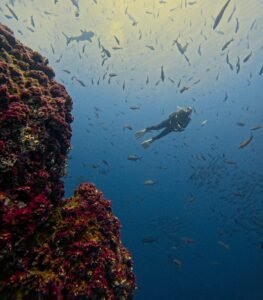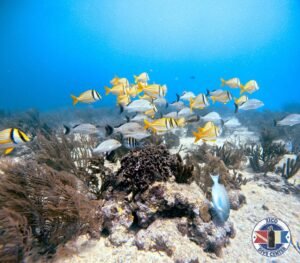Welcome, fellow diving enthusiasts! Whether you’re an experienced diver or just dipping your toes into the underwater world, understanding the language of scuba diving is essential for a safe and enjoyable experience. Welcome to the ABCs of Diving, where we will explore different scuba diving terms as we go through the alphabet. To read previous posts from this column check out our other blogs. Today we continue with the letters O:

Octopus Regulator: An Octopus Regulator is a secondary or backup breathing regulator that is part of a diver’s equipment. It is designed to be used in case of an emergency, such as if the primary regulator fails or if a buddy needs air. The octopus regulator is typically attached to the diver’s gear with a bright-colored hose for easy identification and access.
OOA (Out of Air): OOA (Out of Air) is a critical emergency situation in diving where a diver has exhausted their air supply. In such cases, the diver needs to switch to a buddy’s alternate air source or ascend immediately to ensure their safety. Divers are trained to handle OOA situations through proper planning, equipment checks, and emergency procedures.
Open-Water Certification: Open-Water Certification is a foundational certification level in recreational diving. It indicates that a diver has completed the necessary training and practical experience to safely conduct dives in open water. At Xico Dive Center we offer the PADI Open Water Course, which includes a classroom instruction, confined water training, and a series of open-water dives.
O-Ring: An O-Ring is a small, circular seal made of rubber or other flexible materials used in diving equipment to prevent leaks. O-rings are commonly found in regulators, valves, and other components that need to maintain a watertight seal. Regular maintenance and inspection of O-rings are crucial to ensure the safety and proper functioning of diving gear.
Overhead: The term Overhead refers to any diving environment where the diver is submerged under a solid structure or where there is no direct ascent to the surface, such as in caves, wrecks, or ice diving. Diving in overhead environments requires special training and equipment due to the increased risks and limited access to the surface in case of an emergency.
Overweighting: Overweighting occurs when a diver carries more weight than needed to achieve proper buoyancy. This can make it difficult to control buoyancy and can lead to challenges in managing ascents and descents. Proper weighting is essential for safety and comfort, and divers should ensure they have an appropriate amount of weight based on their gear and body type.
Oxygen Toxicity: Oxygen Toxicity is a condition that results from breathing high concentrations of oxygen under increased pressure. This can lead to symptoms such as nausea, twitching, and, in severe cases, seizures. Oxygen toxicity is a significant concern in technical diving with high-oxygen mixtures or deep dives. Divers must be trained to understand and manage the risks associated with oxygen exposure.
Scuba diving is a blend of technical skill, environmental awareness, and appreciation for marine life. By familiarizing yourself with these diving terms, you’ll enhance your diving knowledge and safety practices, ensuring each underwater adventure is a memorable and enjoyable experience. Whether you’re exploring reefs, wrecks, or underwater caves, the underwater world awaits with its mysteries and beauty. Happy diving!


